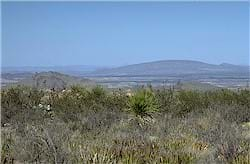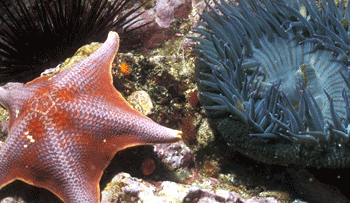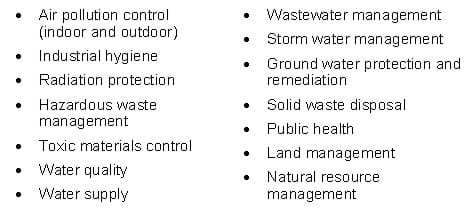Quick Look
Grade Level: 4 (3-5)
Time Required: 45 minutes
Lesson Dependency: None

Summary
Students learn about both natural and human-made environments and explore interactions within them through written and hands-on webbing associated activities. They also learn about environmental engineering careers and the roles of these engineers in our society.Engineering Connection
Environmental engineers design and build a range of projects and systems in our natural and human-made surroundings. For example, projects that re-direct a river's natural flow or restore contaminated rivers are types of environmental challenges that engineers take on. They also solve environmental problems that involve air pollution, public health, waste disposal, toxic materials control or land protection, among many others.
Learning Objectives
After this lesson, students should be able to:
- Describe an environment.
- Identify interactions taking place in an environment.
- Appreciate the degree to which living and non-living things depend on one another.
- Classify parts of the environment as either biotic or abiotic.
- Identify and understand the roles of environmental engineers in our society.
Educational Standards
Each TeachEngineering lesson or activity is correlated to one or more K-12 science,
technology, engineering or math (STEM) educational standards.
All 100,000+ K-12 STEM standards covered in TeachEngineering are collected, maintained and packaged by the Achievement Standards Network (ASN),
a project of D2L (www.achievementstandards.org).
In the ASN, standards are hierarchically structured: first by source; e.g., by state; within source by type; e.g., science or mathematics;
within type by subtype, then by grade, etc.
Each TeachEngineering lesson or activity is correlated to one or more K-12 science, technology, engineering or math (STEM) educational standards.
All 100,000+ K-12 STEM standards covered in TeachEngineering are collected, maintained and packaged by the Achievement Standards Network (ASN), a project of D2L (www.achievementstandards.org).
In the ASN, standards are hierarchically structured: first by source; e.g., by state; within source by type; e.g., science or mathematics; within type by subtype, then by grade, etc.
NGSS: Next Generation Science Standards - Science
-
CCC.4.3-5.2.
A system can be described in terms of its components and their interactions.
(Grades 3 - 5)
More Details
Do you agree with this alignment?
International Technology and Engineering Educators Association - Technology
-
Compare how things found in nature differ from things that are human-made, noting differences and similarities in how they are produced and used.
(Grades
3 -
5)
More Details
Do you agree with this alignment?
State Standards
Colorado - Science
-
Identify the components that make a habitat type unique
(Grade
4)
More Details
Do you agree with this alignment?
Introduction/Motivation
Are you concerned about the natural and human-made environment? Are you interested in solving problems related to water or air pollution, solid waste disposal, recycling, preserving the rainforests, new types of energy, how we use our natural resources, etc.? If you have answered yes to any of these questions, you would likely be interested in learning more about becoming an environmental engineer when you grow up.


There are two types of environments that exist: 1) the natural environment (see Figure 1), and 2) the human-made environment (see Figure 2). Can you think of things in your environment that are natural? (Have students brainstorm answers, such as water, air, sun, soil, food, animals, etc.) The natural environment is split into two parts: living things, which we call biotic, such as plants and animals; and non-living things, which we call abiotic, such as water, air and sunlight. Can you think of things in your environment that are human-made? (Have students brainstorm ideas, such as houses, cars, clothing, etc.) Could you live without the environment? (Answer: You can live without some parts of it, but you cannot live without the LAWS: light, air, water and soil.) Are there some parts of your environment that you could live without? (Answer: Yes, you can live without your computer, rollerblades, bike, electronic games, mountains, etc. You cannot live without light, air, water and soil.)
The environment affects your health and well-being, in addition to your choices for entertainment, occupation, clothing, etc. Environmental engineers design and create a vast majority of things we use in the environment in everyday life. They also control and fix parts of our environments that are natural and human-made, such as the direction of a river or the contamination of a river. They work with everything from air pollution, hazardous and toxic materials and water supplies to waste disposal, public health, land and other natural resources.
Lesson Background and Concepts for Teachers
History of Environmental Engineering
Environmental engineering came about in the 1800s, post Civil War due to life-threatening water quality and air quality problems. In 1830, environmental engineers designed the first water supply systems in the United States. Furthermore, by 1939, the start of World War II, environmental engineers ensured that water was safe to drink. Environmental engineering continues to be a recognized profession today because of the continuing need for pollution control, among other environmental issues.
The Role of Environmental Engineering
Environmental engineers assess and manage the effects of human and other activity on the natural and human-built environment. They work in many different major categories of environmental protection:

Environmental engineers have diverse roles within these major categories. They frequently work closely with other professionals, at times pooling expertise on particular projects. They can be:

Additionally, there are several different types of companies or organizations who employ environmental engineers:

The Environments in Which We Live
A natural environment consists of two parts: abiotic (the physical environment) and biotic (the living environment), as well as the interactions between and within them. Refer to the associated activity Environmental Interactions to have students create a "web" to identify and demonstrate the interactions between and among the living and non-living parts of an environment.
Abiotic (physical) environment – includes the natural environment of light, air, water and soil (the environmental LAWS), as well as the human-made environment (houses, stereos, tennis shoes, gum wrappers, etc.). An abiotic environment changes naturally from weathering, erosion, and so forth, but often so slowly that we often do not even notice its change. The effects of human activities (such as clearing a mountain to make a ski area) alter it much more immediately and obviously than natural activities. The natural physical environment is also made up of three parts: the lithosphere (the rocky part), the hydrosphere (the watery part), and the atmosphere (the gassy part).
Environments contain abiotic (non-living) factors, but the extent of their presence varies. These non-living factors are known as the environmental LAWS and are represented by: L – Light; A – Air; W – Water; and S – Soil. Refer to the associated activity Moebius Strips to demonstrate the interconnectedness of an environment and to explore natural cycles (water, oxygen/carbon dioxide, carbon, nitrogen) within the environment.
Biotic (living) environment – includes plants and animals (consumers, producers and decomposers). About 1.2 million species of plants and animals have been discovered and described, but it is estimated that there may be around 8.7 million species on Earth.
Producers are mainly green plants, and they fix the sun's energy and make food from simple substances. Consumers use the food stored by the producers. Decomposers are mainly bacteria and fungi and break down complex compounds into raw materials to be used again by the producers.
A human-made environment is any non-natural environment. Humans first began to severely alter the natural environment when they began farming approximately 10,000 years ago. Since then, humans have modified the natural environment in many ways through agriculture, architecture, industry, transportation, etc. As a result of an ever growing human population, the human-made environment is blamed for the major environmental problems (including air and water pollution, among others) facing us today.
Students and teachers can find out about many different engineering disciplines at https://www.teachengineering.org/k12engineering/types-of-engineering.
Some biographies of people who work in environmental professions can be found at the following website: https://www.thirteen.org/edonline/wue/cool_careers.html.
Associated Activities
- Moebius Strips - Students use Moebius strips (a loop of paper with a half twist in it) to demonstrate the interconnectedness of an environment and to explore natural cycles (water, oxygen/carbon dioxide, carbon, nitrogen) within the environment.
- Environmental Interactions - Students create a "web" to identify and demonstrate the interactions between and among the living and non-living parts of an environment. They use this information to better understand what an environment is and to consider how engineers use teamwork.
Lesson Closure
Review key vocabulary, especially abiotic factors and biotic factors, and reiterate the roles that environmental engineers play in society. (Reminder: Environmental engineers assess and manage the effects of human and other activity on the natural and human-made environment. Their roles include: researchers, designers, planners, pollution control facility operators, program managers, professional society workers, professors, government regulatory agency officials.)
Vocabulary/Definitions
abiotic factor: The parts of the environment that are non-living (a mountain, water, volcano, air, cars, etc.).
biotic factor: The parts of the environment that are living or were once living (dinosaurs, trees, grasshoppers, corn, etc.).
environment: The physical surroundings of an organism, including all the conditions and circumstances that affect its development (everything that surrounds you is your environment).
environmental engineer: A person who solves problems related to protecting the environment.
interaction: A relationship between parts of the environment.
LAWS: Light, air, water, soil
Assessment
Pre-Lesson Assessment
Idea Web: Ask students to brainstorm a list of answers to a question. This may be done as a class, in small groups, or even as a possible homework assignment the day before starting the unit. As a class, use their answers to create an idea web (on the board, an overhead, etc.). An idea web is a network of logically interconnected ideas. For example, the idea "rain" might be connected with a body of water, "lake." Ask the class to decide if anything needs to be added to the web. Be sure they have included living and non-living items (especially LAWS: light, air, water and soil). Ask them:
- What is an environment? (Answer: Your environment is everything that surrounds you, both natural and human-made items.)
- What things make up an environment? (Answer: Your environment is everything that surrounds you, both natural and human-made items.)
Post Introduction Assessment
Question/Answer: As a class, discuss some of the following questions:
- How important do you think the environment is to your life? (Answer: Very important; the environment affects your health and well-being, as well as choices for entertainment, occupation, clothing, etc.)
- Could you live without the environment? (Answer: You can live without some parts of the environment, but you cannot live without the LAWS — light, air, water and soil.)
- Are there some parts of your environment that you could live without? (Answer: Yes, you can live without your computer, rollerblades, bike, electronic games, mountains, etc. You cannot live without light, air, water and soil.)
- What do you think an environmental engineer does? (Answer: See ideas in the Background section. Let students know that they will be learning much more about this in this unit.)
- Are you concerned about the natural and human-made environment? Are you interested in solving problems related to water or air pollution, solid waste disposal, recycling, preserving the rainforests, new types of energy, how we use our natural resources, etc.? (Note: Let students know that if they answered yes to any of these questions, they may be interested in becoming an environmental engineer.)
Lesson Summary Assessment
Bingo: Provide each student with a sheet of paper containing a list of the lesson vocabulary terms. Have each student walk around the room and find a student who can define one vocabulary term. Students must find a different student for each word. When a student has all terms completed s/he shouts "Bingo!" Continue until two or three (or most) students have bingo. Ask the students who shouted "Bingo!" to give definitions of the vocabulary terms.
Homework
Figure Drawing: Ask students to draw a picture of an environment that they spend time in outside of school; for example, their bedroom, a park, ballet class, etc. On the second day, have students present their pictures and ideas with the class. Collect and review the students' homework. They should follow the steps below:
- Name the environment they draw and be able to describe why it is an environment.
- List the biotic and abiotic factors in the environment.
- Describe at least five interactions that take place in the environment, with at least two of them being multi-step interactions.
- Describe at least one cycle that occurs in this environment (like clean laundry is removed from the closet and worn, it is then placed in the laundry hamper, laundry in the hamper gets washed, and clean laundry gets hung back up in closet).
- Describe what type of environmental engineer might interact with their drawn environment. (This allows for a little imagination and humor, especially if they are describing their bedroom or other home environment. For example, a student that has a very messy room may need a hazardous waste engineer! You may need to review some of the types of environmental engineers with them.)
Lesson Extension Activities
Current Events – Ask students to bring in articles from newspapers, magazines, etc. that discuss the environment and environmental engineers. Discuss the environmental engineer's role. Following are some websites for obtaining current environmental articles:
www.enn.com
www.cnn.com
https://www.sciencedaily.com/news/earth_climate/
https://www.pollutiononline.com/resource/news
Pick an environmental novel or picture books to read (as a class or as a read-aloud). (Note: You may refer to the References section for some book ideas.)
Ask students to review any environmental engineering job postings on websites like Indeed.com, or have them research the job at https://www.bls.gov/ooh/architecture-and-engineering/environmental-engineers.htm. Ask them to develop a general profile of an environmental engineer, including schooling, skills, other necessary experience, salary, etc.
Have students research different university web sites for descriptions and requirements for environmental engineering programs and degrees. They should develop a general profile of an environmental engineering education and career.
Ask different groups of students to research and write letters to different types of environmental engineers (water, solid waste, consultants, land management, etc.). Students should ask each engineer to define "environment" in his/her own words. The class can compare the results once the students' response letters have returned.
Invite an environmental engineer as a guest speaker. A student my have a relative or friend that will be willing to speak to the class. Or, call the US Environmental Protection Agency (EPA), the National Renewable Energy Laboratory (NREL), the local water treatment plant (drinking or waste), a recycling company, or a consulting firm, etc. and ask if they have someone who could come and speak to the class. Ask the guest speaker to define "environment" in his/her own words and compare with the class's definition. Ask the speaker to describe the different types of interactions/relationships s/he deals with in the environment. Ask the speaker to describe his/her career in detail.
Display different pictures of different types of environments and ask the students to describe the interactions that take place there. Have them discuss the types of environmental engineer that may come in contact with the environment.
Subscribe
Get the inside scoop on all things TeachEngineering such as new site features, curriculum updates, video releases, and more by signing up for our newsletter!More Curriculum Like This

With a continued focus on the Sonoran Desert, students are introduced to the concepts of biomes, limiting factors (resources), carrying capacity and growth curves. By studying these ecological relationships, students see the connection between ecological relationships of organisms and the fundamenta...

Students are introduced to the concepts of air pollution, air quality, and climate change. The three lesson parts (including the associated activities) focus on the prerequisites for understanding air pollution. First, students use M&M® candies to create pie graphs that express their understanding o...

Students gain an understanding of the parts of a plant, plant types and how they produce their own food from sunlight through photosynthesis. They learn how plants play an important part in maintaining a balanced environment in which the living organisms of the Earth survive. This lesson is part of ...

In this multi-day activity, students explore environments, ecosystems, energy flow and organism interactions by creating a scale model biodome, following the steps of the engineering design process.
References
Chandler, Pauline. Environmental Issues (Hand-On Minds-On Science Series): Intermediate, Westminster, California: Teacher Created Materials, Inc., 1994.
Cole, Joanna, and Bruce Degen. The Magic School Bus and the Climate Challenge. New York, NY: Scholastic, 2010.
Durell, Ann, Craighead George, Jean and Paterson, Katherine (eds). The Big Book For Our Planet (First Edition). New York: Dutton Children's Books, 1993.
Kerrod, Robin. Let's Investigate Science – The Environment. New York: Marshall Cavendish Corporation, 1994.
MacKay, Amanda. The Little Beaver and the Beautiful Forest. Toronto, ON, CAN: CreateSpace Independent Publishing Platform, 2014.
McFadden (ed). Science Plus – Technology and Society (Level Red). Austin, TX: Holt, Rinehart and Winston, 1993.
Mora C, Tittensor DP, Adl S, Simpson AGB, Worm B (2011) How Many Species Are There on Earth and in the Ocean? PLoS Biol 9(8): e1001127. doi:10.1371/journal.pbio.1001127
Paul, Miranda, and Elizabeth Zunon. One Plastic Bag: Isatou Ceesay and the Recycling Women of the Gambia. Minneapolis, MN: Findaway World, LLC., 2015.
Rohmer, Harriet, and Julie McLaughlin. Heroes of the Environment: True Stories of People Who Are Helping to Protect Our Planet. San Francisco, CA: Chronicle Books, 2009.
Verde, Susan, et al. The Water Princess. New York, NY: G.P. Putnams Sons, 2016.
https://www.teachengineering.org/k12engineering/types-of-engineering
www.thirteen.org/edonline/wue/cool_careers.html
https://cee.mines.edu/
https://www.nationalgeographic.org/encyclopedia/biodiversity/
Other Related Information
(optional: Show students the What Is Engineering? video)
Copyright
© 2005 by Regents of the University of Colorado.Contributors
Amy Kolenbrander; Jessica Todd; Malinda Schaefer Zarske; Janet YowellSupporting Program
Integrated Teaching and Learning Program, College of Engineering, University of Colorado BoulderAcknowledgements
The contents of this digital library curriculum were developed under a grant from the Fund for the Improvement of Postsecondary Education (FIPSE), U.S. Department of Education and National Science Foundation GK-12 grant no. 0338326. However, these contents do not necessarily represent the policies of the Department of Education or National Science Foundation, and you should not assume endorsement by the federal government.
Last modified: December 4, 2021









User Comments & Tips